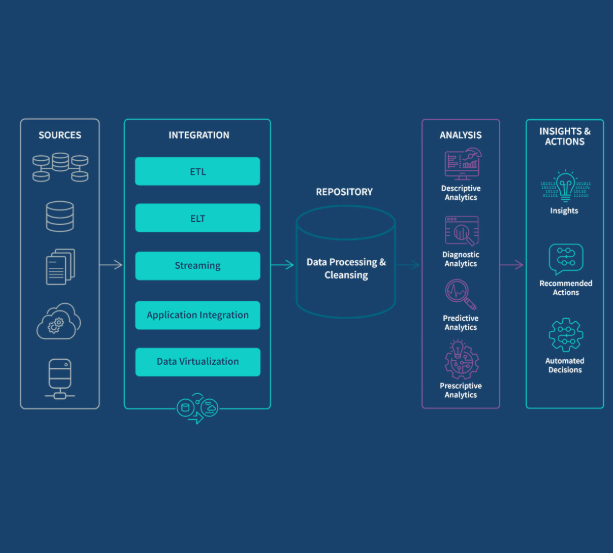
Artificial Intelligence (AI) relies heavily on data to make decisions, identify patterns, and predict outcomes. The value derived from AI depends entirely on the quality of the data it processes. However, many businesses fail to see positive results from their AI projects due to poor data quality, improper data strategies, and a lack of adequate planning. According to a study by MIT Sloan Management Review, 70% of organizations struggle to gain benefits from their AI initiatives for these reasons.
As the global economy looks towards AI to potentially generate $4.4 trillion annually by 2030, preparing AI-ready data has become more important than ever. Data quality, accuracy, and structure are now fundamental pillars for business growth and innovation.
This article explores the concept of AI-ready data, its key characteristics, common challenges, and effective strategies for preparing data to maximize the potential of AI systems.
What is AI-Ready Data?
AI-ready data refers to information that has been properly cleaned, organized, and optimized to be utilized by AI models. The quality of data plays a critical role, as the AI’s effectiveness depends on the accuracy, relevance, and structure of the data provided. AI-ready data is formatted and organized to meet the specific needs of AI algorithms, ensuring fast processing, reliable outcomes, and efficient analysis.
For data to be considered AI-ready, it should meet the following standards:
- Well-Structured: Data must be organized in a way that supports AI model integration and processing.
- Rich in Context: It should provide enough contextual information for AI to generate actionable insights.
- High Quality: Data must be accurate, complete, and consistent to minimize errors and avoid bias in predictions.
In short, AI-ready data should be structured, relevant, and clean, making it suitable for AI-powered decision-making.
Key Traits of AI-Ready Data
Here are the key characteristics that define AI-ready data:
1. Structured Format
While AI systems can handle unstructured data like text and images, structured data (organized in tables or databases) enables faster and more accurate processing. Structured data reduces computational needs, allowing AI models to process and analyze data quickly. For example, customer data like purchase history and engagement metrics can help AI models create tailored marketing strategies to enhance customer retention.
2. High Quality
For AI systems to function optimally, the data used must be accurate, reliable, and consistent. High-quality data ensures the AI model is trained on valid inputs, leading to more dependable outcomes. Inaccurate or inconsistent data can lead to flawed predictions and poor decision-making, which is why high-quality data is critical.
3. Timeliness and Relevance
Up-to-date, relevant data is essential for AI applications to function effectively. Using outdated data, particularly in rapidly changing fields like healthcare or finance, can result in poor predictions and misguided decisions. AI systems rely on real-time, relevant data to make quick, accurate decisions. For example, AI-driven stock trading systems need real-time market data to adjust strategies based on current market conditions.
4. Comprehensive Coverage
AI systems perform better when they have access to diverse and comprehensive data. Including a wide range of variables enables the AI to generate better predictions and understand complex real-world scenarios. For instance, analyzing customer behavior with data on past purchases, browsing history, and demographics allows AI models to predict future purchasing patterns more accurately.
5. Data Integrity and Security
AI-ready data must be secure, ensuring its authenticity and protection from unauthorized access or alterations. Data breaches or unauthorized changes can compromise the integrity of the data, undermining trust in AI systems. Implementing strong encryption, access controls, and regular audits helps ensure that data is safe and secure, particularly in sensitive sectors like healthcare and finance.
Essential Factors for AI-Ready Data
For organizations to fully benefit from AI, they need to address several key factors that power AI-ready data:
1. Blending Structured and Unstructured Data
AI systems often work with both structured and unstructured data, such as text, video, and database records. Integrating these diverse data types into a cohesive structure is essential for building AI models that can generate more profound insights. Organizations need strategies to manage and integrate data from various formats effectively.
2. Evolving Data Management Practices
As AI technology evolves, so too must data management strategies. Traditional data management methods are no longer sufficient. The development of new practices like data fabrics and augmented data management helps improve the quality and accessibility of data for AI applications. Advanced tools like knowledge graphs allow AI models to understand data context and integrate various datasets more efficiently.
3. Ensuring Data Quality and Accessibility
AI systems are highly dependent on clean, accurate, and accessible data. Organizations often overlook challenges like data bias and inconsistency, which can hinder AI performance. To achieve AI-readiness, businesses must prioritize data quality by addressing issues such as bias and ensuring that the data is accurate, representative, and unbiased.
4. Addressing Bias and False Outputs
AI systems must be trained on unbiased data to avoid generating false or misleading results. Effective data governance and quality assurance processes are essential to mitigate bias and ensure that AI outputs are accurate and fair. By addressing these issues early in the data preparation process, organizations can improve the reliability of AI systems.
Steps to Achieve AI-Ready Data
Organizations looking to adopt AI must follow a strategic approach to prepare their data for AI models. Here’s a step-by-step guide to achieve AI-readiness:
Step 1: Create a Data Inventory Aligned with Use Cases
Identify key datasets that align with high-priority AI projects. This inventory should be created in collaboration with data stewards and operations teams, ensuring data ownership, accessibility, and organization.
Step 2: Evaluate Data Integrity and Coverage
Examine the data for completeness and quality. Ensure that it is clean, comprehensive, and relevant to the intended AI use case. For instance, organizations can start by using high-quality data, even if it’s limited, to create initial AI models and refine them over time.
Step 3: Centralize Data Assets
Consolidate key datasets into a central repository, such as a cloud data platform or data lake. A unified data environment allows teams to collaborate more effectively and facilitates easier access to data for AI model development.
Step 4: Assess Data Suitability for AI Models
Once data is centralized, evaluate its suitability for AI applications. Ensure the data is clean, relevant, and granular enough for the model to perform well. For example, cleaning datasets and integrating external data sources can improve the accuracy of predictive models.
Step 5: Implement Strong Data Governance
Establish data governance frameworks that define roles, quality standards, and access protocols. A robust governance model helps ensure that data is managed effectively, remains secure, and meets regulatory requirements.
Challenges to AI-Ready Data
While preparing AI-ready data is essential, organizations face several challenges along the way:
1. Fragmented Data Sources
Data often exists in silos across different departments, leading to incomplete datasets. AI systems require holistic datasets to find correlations and generate insights. By consolidating data into a unified architecture, businesses can ensure smooth data flow and more accurate AI outcomes.
2. Lack of Standardization
Inconsistent data formats and terminologies can confuse AI systems, reducing their ability to learn effectively. Standardizing data labeling, formats, and structures across the organization helps AI models interpret data more accurately.
3. Poor Data Hygiene
Erroneous or incomplete data can lead to incorrect predictions. By implementing data cleansing workflows and using tools like anomaly detection, organizations can ensure that the data used for AI is reliable and ready for analysis.
4. Data Privacy and Governance Issues
AI projects often handle sensitive data, making strong governance and security protocols crucial. Organizations must implement encryption, authentication measures, and privacy protection techniques to ensure data integrity and compliance with regulations.
Why Is AI-Ready Data Crucial?
Faster AI Development
Having AI-ready data speeds up the development process by reducing the time spent on data wrangling. This allows data scientists to focus on refining AI models, which accelerates the deployment of AI applications in industries like healthcare, finance, and logistics.
Lower Costs
AI-ready data eliminates the need for extensive manual data preparation, reducing operational costs. With standardized and cleaned data, organizations save both time and money, enabling them to allocate resources to innovation instead of data preparation.
Improved Model Performance
AI models are only as effective as the data they are trained on. Accurate, relevant, and high-quality data leads to better model performance, improving decision-making, automation, and predictive capabilities across the business.
Conclusion
AI-ready data is the foundation for successful AI projects. It enables faster, more accurate AI applications and reduces the time and cost spent on data preparation. By focusing on data quality, structure, and security, organizations can unlock the full potential of AI, making data a strategic asset that drives business growth. Investing in AI-ready data today sets the stage for continued innovation and success in the AI-powered future.















































